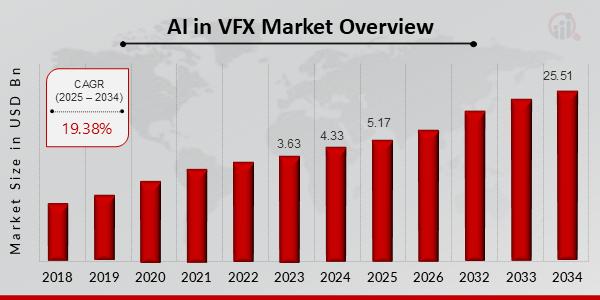The Transformative Landscape of AI in Visual Effects and Technology Innovations
Author: News Analyst

In recent years, the role of artificial intelligence (AI) within the technology sector has evolved drastically, impacting a multitude of industries from visual effects (VFX) to telecommunications. One of the most prominent developments is the AI in VFX market, which is projected to reach a staggering USD 25.51 billion by 2034, growing at an impressive compound annual growth rate (CAGR) of 19.38%. This growth underscores the transformative power of AI in reshaping how visual storytelling is conceived and executed across film, television, gaming, and advertising.
The advent of AI in visual effects marks a revolutionary era in content creation. With AI tools, artists can now streamline workflows, enhance creative possibilities, and reduce production times while maintaining high-quality output. By leveraging advanced machine learning algorithms, VFX companies can create hyper-realistic visuals that were once deemed impossible. This technological shift not only improves efficiency but also democratizes the production of high-quality visuals, allowing smaller studios to compete alongside industry giants.

AI technologies significantly boost creativity in the VFX market, offering innovative solutions for production.
In a notable advertisement, Google has taken a strategic jab at rival Apple, highlighting the delays in Apple’s Siri AI upgrade through its latest Google Pixel 10 teaser. This advertising tactic exemplifies how tech companies leverage AI advancements not just for feature enhancement but also as a competitive marketing strategy, engaging consumers by showcasing notable contrasts between their products and those of their competitors.
As artificial intelligence continues to dominate industry discussions, companies like Nvidia are experiencing unprecedented growth in wealth among their employees. A recent report reveals that nearly 80% of Nvidia's workforce has already achieved millionaire status largely due to the company's bold forays into AI technology and its resultant market influence. This trend not only signifies the economic impacts of technological advancement but also emphasizes how innovation can lead to substantial personal financial gain.

Nvidia employees are experiencing significant financial benefits due to the company’s leadership in AI technology.
Meanwhile, developments in the telecommunications sector are poised to drastically alter internet access in regions across India. Following the acquisition of a Unified License, Elon Musk’s Starlink has garnered government approval to operate within the country. This milestone paves the way for enhanced connectivity in rural areas, a region traditionally underserved by conventional telecom services. As Starlink sets out to bridge the digital divide, the implications for rural economies and individual connectivity are monumental.
Furthermore, SK Telecom exemplifies the trend of utilizing cutting-edge technology for enhanced service offerings by launching Korea’s largest GPU cloud service, based on Nvidia’s latest B200 semiconductors. The GPU-as-a-Service (GPUaaS) enables businesses to harness immense computational power for tasks including AI model training and complex simulations, further showcasing how AI and associated technologies are reshaping operational efficiencies within industries.

SK Telecom's GPU-as-a-Service offers substantial computational power, highlighting the growth of cloud technologies.
In the realm of storage technology, KIOXIA has unveiled the first-ever 245TB SSD specifically designed for AI applications at the Future of Memory and Storage event. This breakthrough is indicative of the increasing demands placed on data storage solutions as AI technologies proliferate. Larger and faster storage options will play a crucial role in enabling real-time data processing and analysis, thus supporting more sophisticated AI applications.
The ongoing advancements in AI and its integration into various domains have also sparked interest in the cryptocurrency market. Recent analysis suggests that the new AI token, Ozak AI, is gaining traction and could potentially deliver a remarkable 100x return for investors in the altcoin surge of 2025. This appetite for AI-powered digital assets reflects a growing intersection between traditional tech sectors and the innovative financial realm.

Ozak AI is set to revolutionize the cryptocurrency landscape with its AI-driven features.
Lastly, AI-driven creative tools such as Elon Musk’s Grok Imagine are now readily available to users, allowing for rapid image and video generation from text prompts. This innovation significantly enhances user engagement and provides new creative avenues for individuals and businesses alike. By bringing text to visual life in mere seconds, such tools democratize content creation and empower users to express their ideas in dynamic ways.
In conclusion, the impacts of artificial intelligence across various sectors are reshaping the landscape of technology in profound ways. From visual effects and image generation to revolutionary storage solutions and telecommunications, AI's influence is evident. As industries adapt to these changes, the economic and creative opportunities brought forth by AI will continue to expand, reinforcing the need for ongoing innovation and adaptation in an increasingly digital world.